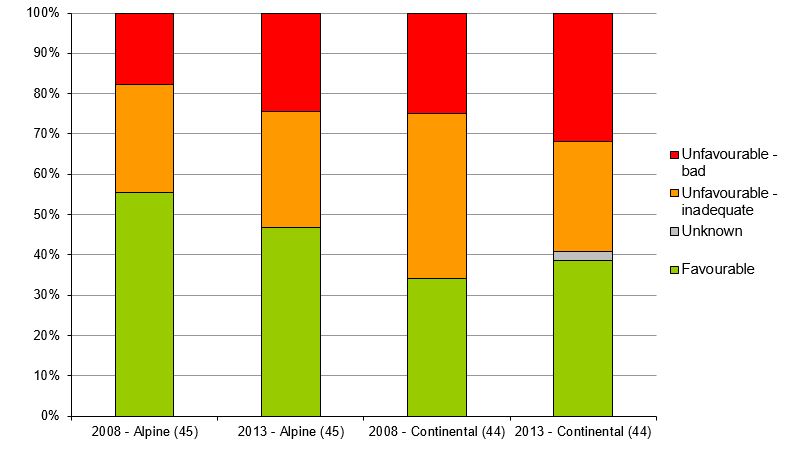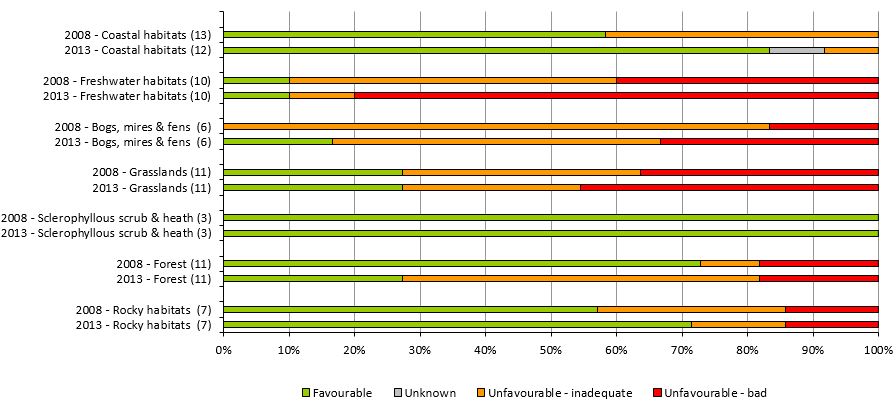[NB12] Habitats of European interest

Key message

Although almost half of habitat types in Slovenia are in a favourable state of preservation, we should consistently follow the guidelines of the Directive and implement the programmes and management plans for protected areas in order to continue to achieve the objectives set out in the Strategy. This is particularly important for areas with fresh water, wetland, bog and grassland habitat types.
Definition
This indicator follows the conservation status of habitat types of European interest. These include the habitat types from the Habitats Directive (Council Directive 92/43/EEC), as listed in Annex I. The indicator is used to assess whether:
- natural ranges and surface areas covered by habitat types in those areas are stable or are not being reduced;
- special structures and functions required for their long-term conservation are in place and are likely to exist in the future;
- the conservation status of their characteristic species is favourable.
The conservation status of habitat types is thus used to measure impacts on individual habitat types and their characteristic species.
Charts
Reports under Article 17 on the conservation status of habitats and species under the Habitats Directive for the period 2004 – 2006 and 2007 - 2012, Ministry of the Environmet and Spatial planning, Institute of the Republic of Slovenia for Nature Conservation, 2013
| 2008 - Alpine (45) | 2013 - Alpine (45) | 2008 - Continental (44) | 2013 - Continental (44) | ||
|---|---|---|---|---|---|
| Favourable | number | 25 | 21 | 15 | 17 |
| Unknown | number | 0 | 0 | 0 | 1 |
| Unfavourable - inadequate | number | 12 | 13 | 18 | 12 |
| Unfavourable - bad | number | 8 | 11 | 11 | 14 |
Reports under Article 17 on the conservation status of habitats and species under the Habitats Directive for the period 2004 – 2006 and 2007 - 2012, Ministry of the Environmet and Spatial planning, Institute of the Republic of Slovenia for Nature Conservation, 2013
| Favourable | Unknown | Unfavourable - inadequate | Unfavourable - bad | ||
|---|---|---|---|---|---|
| Sclerophyllous scrub (3) | number | 2 | 0 | 1 | 0 |
| Rocky habitats (7) | number | 4 | 0 | 2 | 1 |
| Heath & scrub (1) | number | 1 | 0 | 0 | 0 |
| Grasslands (12) | number | 3 | 0 | 5 | 4 |
| Freshwater habitats (8) | number | 1 | 0 | 3 | 4 |
| Forest (11) | number | 8 | 0 | 1 | 2 |
| Dunes habitats (0) | number | 0 | 0 | 0 | 0 |
| Coastal habitats (12) | number | 7 | 0 | 4 | 1 |
| Bogs, mires & fens (6) | number | 0 | 0 | 5 | 1 |
Reports under Article 17 on the conservation status of habitats and species under the Habitats Directive for the period 2004 – 2006 and 2007 - 2012, Ministry of the Environmet and Spatial planning, Institute of the Republic of Slovenia for Nature Conservation, 2013
| Actual pressures | Future threats | ||
|---|---|---|---|
| Geological events, natural catastrophes | % | 0 | 0 |
| Unknown threat or pressure | % | 0 | 0 |
| Climate change | % | 4 | 8 |
| Invasive, other problematic species and genes | % | 8 | 11 |
| Forestry | % | 9 | 9 |
| Biological resource use other than agriculture & forestry | % | 9 | 10 |
| Transportation and service corridors | % | 12 | 27 |
| Mining and extraction of materials | % | 13 | 23 |
| Urbanisation, residential and commercial development | % | 15 | 17 |
| Pollution | % | 15 | 20 |
| Natural biotic and abiotic processes | % | 25 | 27 |
| Human intrusions and disturbances | % | 27 | 38 |
| Human induced changes in hydraulic conditions | % | 61 | 71 |
| Agriculture | % | 77 | 74 |
Reports under Article 17 on the conservation status of habitats and species under the Habitats Directive for the period 2004 – 2006 and 2007 - 2012, Ministry of the Environmet and Spatial planning, Institute of the Republic of Slovenia for Nature Conservation, 2013
State of nature in the EU – results from reporting under the nature directives 2007-2012. EEA Technical report No 2/2015.
| Favourable | Unfavourable - inadequate | Unfavourable - bad | Unknown | ||
|---|---|---|---|---|---|
| Slovenia-2008 | % | 43 | 35 | 22 | 0 |
| EU25-2008 | % | 17 | 28 | 37 | 18 |
| Slovenia | % | 43 | 28 | 28 | 1 |
| EU - 27 | % | 16 | 47 | 30 | 7 |
Goals
Main goal (Strategy – Slovenia)
· To maintain a favourable status of habitat types.
Goals by habitat type
Coastal and marine habitat types:
· to reduce water pollution to a level that is non-biologically threatening to exceptionally diverse or well preserved habitat types and habitats of threatened or endemic species;
· to restore degraded habitat types to favourable status, wherever possible;
· to prevent the introduction of non-indigenous species.
Inland waters, bogs, mires and fens:
· to conserve the favourable status of existing ecologically important wetlands and habitat and to restore the ecological integrity of degraded inland waters, bogs and fens, and marshes, where feasible;
· to use an integrated approach to water management;
· To raise water quality, mostly by reducing water pollution to a level not biologically threatening towards exceptionally diverse or well preserved habitat types and habitats of threatened or endemic species;
· to prevent the introduction of non-indigenous species;
· to encourage land use practices that maintain the water cycle and are important for the conservation of biodiversity;
· to adjust land use to natural water regimes.
Habitat types in the agricultural landscape:
· to maintain the current extent of wet and dry grasslands, meadow orchards and hedges.
Forest habitat types:
· to maintain the favourable status of forest habitat types and to expand areas that have favourable status.
Subterranean habitat types:
· to maintain their favourable status and the favourable status of all subterranean fauna.
Goals (Strategy – EU)
To halt the deterioration of all habitats covered by EU nature protection legislation and to achieve significant and measurable improvement to their status so that by 2020, 100% more habitat assessments conducted in accordance with the Habitats Directive will have reach favourable conservation status or show improvement compared to the present assessments. (Strategy – EU)
Comment
A large share (43%) of habitat types of European interest in Slovenia has been assessed as having favourable conservation status. Scrubland and heathland, marine, coastal and barren land habitat types, which are the least exposed to human pressures, have been assessed as having the most favourable conservation status. Freshwater, bog, fen and marshland habitat types are extremely vulnerable due to their small size, which is reflected in their conservation status assessment. Inappropriate management of watercourses, alteration of water regimes, pollution, inappropriate use of water, stream beds and other elements of water bodies, urbanisation and introduction of invasive species are the main factors causing unfavourable conservation status of freshwater, bog, fen and marshland habitat types. Grasslands have also been assessed as having unfavourable conservation status. The intensification of agriculture on one hand, and its abandoning on the other, are the main factors causing unfavourable conservation status of grassland habitat types. Urbanisation, alteration of water regimes and invasive species additionally contribute to unfavourable status. Since 2006, the conservation status of freshwater habitat types has decreased the most – the share of habitat types assessed as having unfavourable conservation status in this category increased by 100%. The conservation status of bog, fen, marshland and grassland habitat types deteriorated significantly as well. At the EU level, the conservation status of habitat types is much worse than in Slovenia – only 17% have been assessed as favourable.












